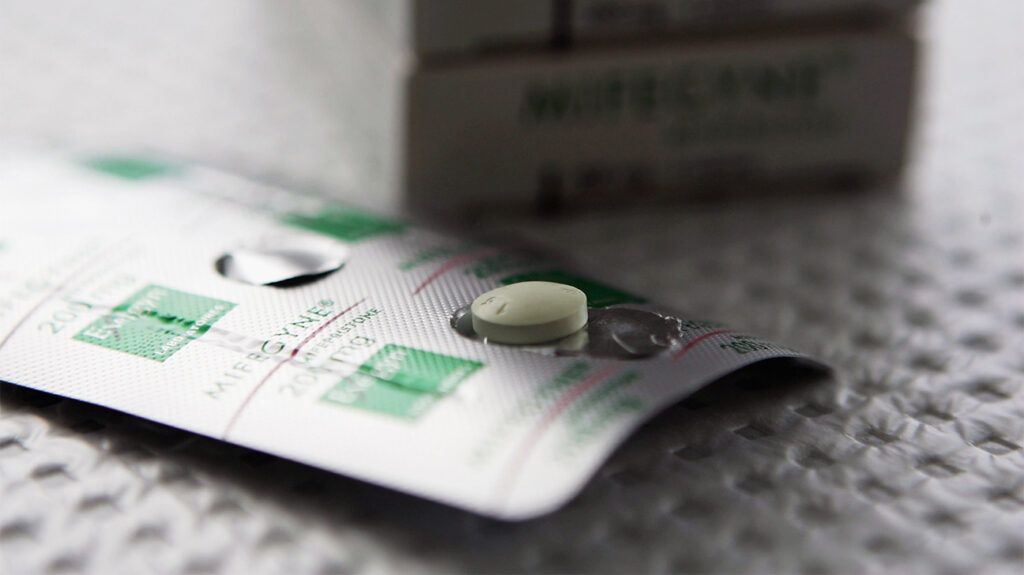The abortion pill is a nonsurgical option to end a pregnancy. Cramping and bleeding are signs that can mean the abortion was successful. Further tests can confirm whether the abortion pill worked.
The abortion pill — also known as a medication abortion — involves taking medications to end a pregnancy. Typically, it will involve two drugs: mifepristone and misoprostol. These drugs work by blocking hormones that are necessary for pregnancy and causing contractions to expel the pregnancy tissue.
Cramping and bleeding are common signs that the abortion pill was effective. Depending on the length of the pregnancy, the bleeding may be similar to a heavy period. To confirm that the medication abortion was successful, a healthcare professional will typically recommend follow-up tests.
Content warning
This article includes content that some readers may find upsetting. Please read at your own discretion.

The most common effects of the abortion pill that suggest it is working are painful cramping and bleeding. These symptoms will usually start a few hours after a person takes the pill and will stop when the pregnancy passes.
These symptoms occur as a result of the uterus contracting to push out the pregnancy tissue. A person may also pass blood clots.
Although some people may expect to see more blood or noticeable clumps of tissue, this may not always be the case. In the earlier stages of pregnancy, the pregnancy tissue may look similar to a heavy period or a miscarriage.
If a person does not experience any bleeding within 24 hours of taking the abortion pill, it is advisable to contact a healthcare professional. Similarly, if they are still experiencing side effects of the abortion pill, such as nausea or vomiting, 24 hours after taking the medication, it may be advisable to contact a doctor.
When taking both mifepristone and misoprostol, a person will first take mifepristone. A healthcare professional will then advise on whether the person should take misoprostol right away or wait up to 48 hours after taking mifepristone.
Cramping and bleeding will usually start within a few hours of taking misoprostol. In many cases, a person will pass the pregnancy tissue within 4 to 6 hours, but this may take up to 24 hours.
In some cases, such as if bleeding does not start or is minimal, a healthcare professional may recommend extra doses of misoprostol to get the pregnancy to pass.
Bleeding and cramping may last up to 24 hours. Typically, the cramping and bleeding slow once the pregnancy tissue passes. However, a person may still experience infrequent cramping for up to 2 days. It is also typical to have some bleeding and spotting for several weeks after taking the abortion pill.
People may describe a medical abortion as feeling similar to a heavy period.
In addition to bleeding and cramping, a person may experience any of the following symptoms:
To ease discomfort during a medication abortion, a person can take pain relievers and anti-nausea medications.
A person may have a variety of emotional reactions when taking an abortion pill. It may be helpful to have a supportive person nearby.
Usually, a medication abortion will involve taking two drugs to end a pregnancy: mifepristone and misoprostol.
First, a person will take mifepristone. This is a tablet that a person takes by mouth. It works by blocking a the progestational hormone progesterone. The female reproductive system releases this hormone, which is necessary for pregnancy.
The drug works by binding to progesterone receptors instead of progesterone. Because the drug blocks the action of progesterone, the uterine lining sheds, and the embryo detaches from the uterine wall. This means the pregnancy cannot continue.
A person will then take misoprostol. A healthcare professional will advise on when a person should take misoprostol. This may be immediately after taking mifepristone or
Misoprostol works by causing contractions of the uterus. As a result, the uterus will expel its contents, including pregnancy tissue.
In some cases, a healthcare professional may suggest taking misoprostol alone. This may involve taking up to 4 doses of misoprostol to end the pregnancy.
Typically, a person will know the medication abortion is over when they stop experiencing symptoms. This will usually involve a reduction in bleeding and the disappearance of other symptoms, such as nausea and vomiting.
To find out for sure whether the abortion pill was successful, follow-up tests are necessary. Typically, this will involve an ultrasound or blood test roughly a week after a person has taken the medications.
A person can also use an at-home pregnancy test to find out whether the pill has worked. However, because levels of pregnancy hormones take some time to decrease, a test may not show a negative result until about a month after the medication abortion.
The abortion pill is a highly effective option. However, its effectiveness decreases as the pregnancy progresses.
A 2022 population study found that for
However, the effectiveness of the abortion pill depends on multiple factors, including how a person takes misoprostol, the time between doses, and how far along the pregnancy is. Taking an additional dose of misoprostol can help increase the effectiveness.
Typically, it is more effective to take both mifepristone and misoprostol. However, in a 2023 study of 637 people who took only misoprostol to end a pregnancy,
The effectiveness of misoprostol alone will also depend on factors such as how far along the pregnancy is and how a person takes the medication.
If the abortion pill is ineffective, a healthcare professional may suggest a different type of abortion.
The abortion pill is a safe and effective way to end an early pregnancy. Signs that the drugs are working include cramping and bleeding, similar to a heavy period, shortly after a person takes them. These symptoms should ease within 24 hours, but some symptoms, such as spotting, may continue for several weeks.
To confirm that the medication abortion was successful, a person will need follow-up testing, such as an ultrasound or blood test. A person can also use a pregnancy test, but it may take longer to provide reliable results.


